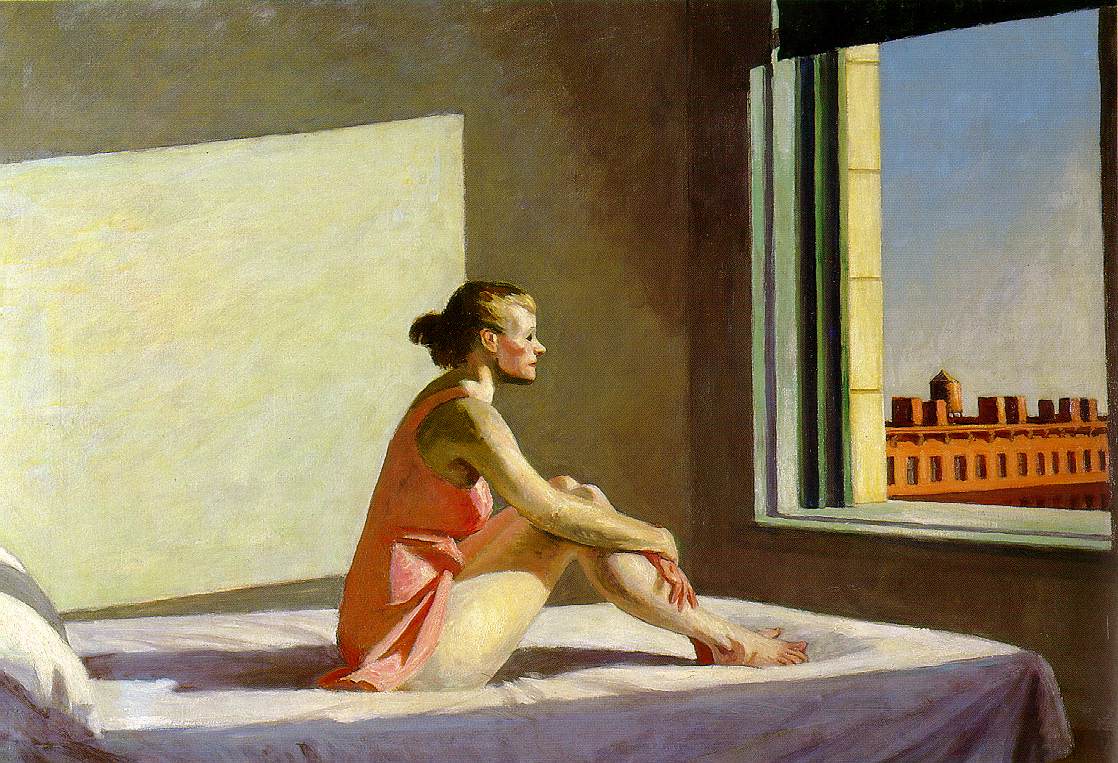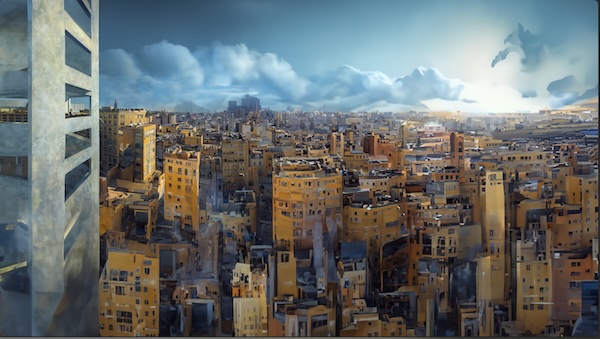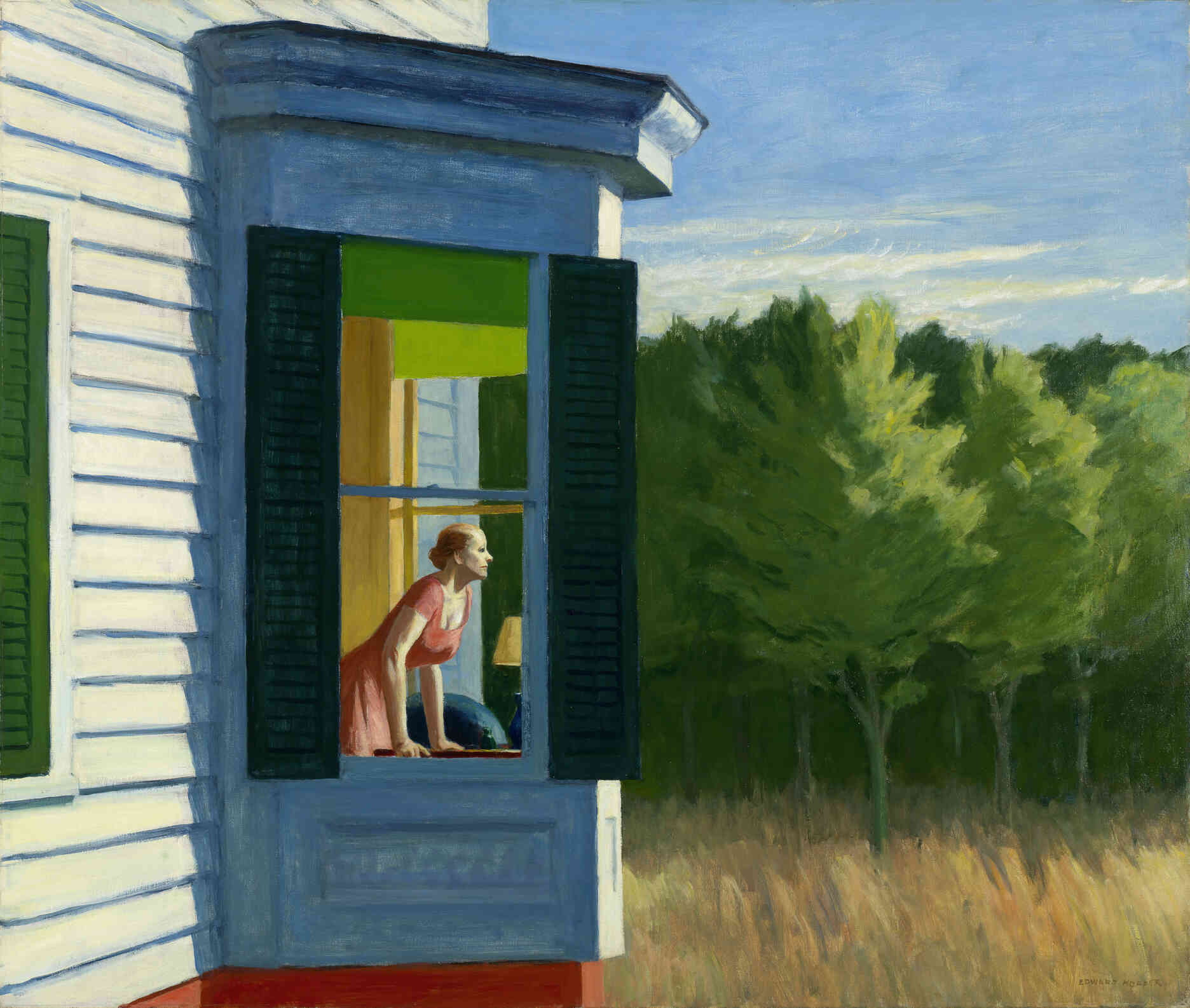No off-screen events
 L’une des caractéristiques de la peinture de Hopper, tient à la mise en tension du hors-champ à partir de la représentation picturale. Les personnages sont immobiles, souvent le regard fixe, dans un instant de temps, qui loin de se refermer sur l’intérieur du tableau, appelle le hors-champ. Que cela soit dans Cape Cod morning, dans City Sunlight, dans Morning sun : les femmes représentées, font face à des fenêtres et regardent vers un extérieur dont le spectateur est privé.
L’une des caractéristiques de la peinture de Hopper, tient à la mise en tension du hors-champ à partir de la représentation picturale. Les personnages sont immobiles, souvent le regard fixe, dans un instant de temps, qui loin de se refermer sur l’intérieur du tableau, appelle le hors-champ. Que cela soit dans Cape Cod morning, dans City Sunlight, dans Morning sun : les femmes représentées, font face à des fenêtres et regardent vers un extérieur dont le spectateur est privé.
En poursuivant la série Completion, je me suis intéressé à ce hors-champ. Il n’existera plus car Hopper est mort. On ne saura jamais ce que ces personnages regardaient. Pourquoi ils étaient ainsi pris par ce qui n’apparaît pas dans l’espace pictural.
 L’IA utilisée dans ce travail ne génère pas avec des prompts. C’est un double processus. d’IA qui a lieu : 1/ le premier est une analyse de l’image 2/ une complétion de l’image à partir de la perception artificielle . L’IA, quelque soit les fantasmes qu’on veuille lui prêter, au niveau de la génération, fonctionne par une induction statistique qui correspond donc à un champ de probabilité de concordance. C’est en ce sens qu’elle ne crée rien d’extraordinaire, mais elle se conforme à un attendu. La question serait e savoir jusque’à quel point elle se conforme. En ce sens, l’ontologie du réel de l’imagination artificielle est strictement tenu dans un déploiement logico-mathématique, même si nous avons l’impression d’une forme de liberté de création dans le processus. Ce qui est survient comme extraordinaire tient surtout à la définition du prompt (recherche à la fois du contenu – et c’est pour cela qu’il y a autant de génération surréaliste ou fantastique ou SF – et des règles de visualisation du contenu). Sans prompts, l’IA générative produit l’image qui sera la plus probable à partir de son contexte. Et de fait c’est cela qu’il faut souligner : l’IA ne créera aucun autre événement dans l’image que de poursuivre un hors-champ à partir du champ.
L’IA utilisée dans ce travail ne génère pas avec des prompts. C’est un double processus. d’IA qui a lieu : 1/ le premier est une analyse de l’image 2/ une complétion de l’image à partir de la perception artificielle . L’IA, quelque soit les fantasmes qu’on veuille lui prêter, au niveau de la génération, fonctionne par une induction statistique qui correspond donc à un champ de probabilité de concordance. C’est en ce sens qu’elle ne crée rien d’extraordinaire, mais elle se conforme à un attendu. La question serait e savoir jusque’à quel point elle se conforme. En ce sens, l’ontologie du réel de l’imagination artificielle est strictement tenu dans un déploiement logico-mathématique, même si nous avons l’impression d’une forme de liberté de création dans le processus. Ce qui est survient comme extraordinaire tient surtout à la définition du prompt (recherche à la fois du contenu – et c’est pour cela qu’il y a autant de génération surréaliste ou fantastique ou SF – et des règles de visualisation du contenu). Sans prompts, l’IA générative produit l’image qui sera la plus probable à partir de son contexte. Et de fait c’est cela qu’il faut souligner : l’IA ne créera aucun autre événement dans l’image que de poursuivre un hors-champ à partir du champ.
 C’est pour cela que cette série de Complétion s’appelle : No camera-off event. Pas d’événement hors-champ. La solitude des personnages de Hopper est ainsi renforcé. Le spectateur n’aura pas la clé du hors-champ, car l’IA poursuivant l’exploration d’un espace ne pense pas la catégorie de l’événement. Elle ne crée pas de « Il arrive ». Cette nouvelle série d’exploration de Hopper se structure tout à la fois sur la production d’images de très grand format (par exemple 16000X8000 pixels) et sur des vidéos qui mettent en tension la liaison entre le champ et le hors-champ.
C’est pour cela que cette série de Complétion s’appelle : No camera-off event. Pas d’événement hors-champ. La solitude des personnages de Hopper est ainsi renforcé. Le spectateur n’aura pas la clé du hors-champ, car l’IA poursuivant l’exploration d’un espace ne pense pas la catégorie de l’événement. Elle ne crée pas de « Il arrive ». Cette nouvelle série d’exploration de Hopper se structure tout à la fois sur la production d’images de très grand format (par exemple 16000X8000 pixels) et sur des vidéos qui mettent en tension la liaison entre le champ et le hors-champ.
// English
One of the characteristics of Hopper’s painting is the tension created off-screen based on the pictorial representation. The characters are immobile, often with a fixed gaze, in a moment of time, which far from closing on the interior of the painting, calls out to the off-camera. Whether in Cape Cod morning, in City Sunlight, in Morning sun: the women represented face windows and look towards an exterior of which the viewer is deprived. While continuing the Completion series, I became interested in this off-camera. He will no longer exist because Hopper is dead. We will never know what these characters were looking at. Why were they so taken by what does not appear in pictorial space.
The AI used in this work does not generate with prompts. It is a double process. of AI which takes place: 1/ the first is an analysis of the image 2/ a completion of the image from artificial perception.
 AI, whatever fantasies we want to attribute to it, at the generation level, works by statistical induction which therefore corresponds to a concordance probability field. It is in this sense that it does not create anything extraordinary, but it conforms to an expectation. The question would be to what extent she complies. In this sense, the ontology of reality of artificial imagination is strictly held in a logical-mathematical deployment, even if we have the impression of a form of creative freedom in the process.
AI, whatever fantasies we want to attribute to it, at the generation level, works by statistical induction which therefore corresponds to a concordance probability field. It is in this sense that it does not create anything extraordinary, but it conforms to an expectation. The question would be to what extent she complies. In this sense, the ontology of reality of artificial imagination is strictly held in a logical-mathematical deployment, even if we have the impression of a form of creative freedom in the process.
 What emerges as extraordinary is mainly due to the definition of the prompt (search for both content – and this is why there is so much surrealist or fantastic or SF generation – and the rules for viewing the content). Without prompts, generative AI produces the image that will be most likely from its context. And in fact this is what must be emphasized: the AI will not create any other event in the image than to pursue an off-camera from the frame. This is why this Completion series is called: No camera-off event. No off-screen events.
What emerges as extraordinary is mainly due to the definition of the prompt (search for both content – and this is why there is so much surrealist or fantastic or SF generation – and the rules for viewing the content). Without prompts, generative AI produces the image that will be most likely from its context. And in fact this is what must be emphasized: the AI will not create any other event in the image than to pursue an off-camera from the frame. This is why this Completion series is called: No camera-off event. No off-screen events.
The solitude of Hopper’s characters is thus reinforced. The spectator will not have the key to the off-camera, because the AI continuing to explore a space does not think about the category of the event. It doesn’t create “He’s coming.” This new exploration series by Hopper is structured both on the production of very large format images (for example 16000X8000 pixels) and on videos which tension the connection between the on-camera and off-camera.